โลราวัน
ระยะไกล
พลังงานต่ำ
สารบัญ
LoRaWAN ในภาพรวม
LoRaWAN® (เครือข่ายระยะไกลและกว้าง) เป็นโปรโตคอลเครือข่ายแบบเปิดที่ใช้พลังงานต่ำ ซึ่งทำงานบนเทคโนโลยีการมอดูเลตวิทยุ LoRa® ของ Semtech เหมาะอย่างยิ่งสำหรับเซ็นเซอร์ที่ใช้พลังงานแบตเตอรี่เพื่อส่งแพ็กเก็ตขนาดเล็กข้ามคลื่นความถี่ต่ำกว่า GHz ที่ไม่ได้รับอนุญาตเป็นระยะทางหลายกิโลเมตร พร้อมเกตเวย์ที่ใช้งานง่ายสำหรับรวบรวมและแพร่สัญญาณไปยังคลาวด์โดยตรง
LoRaWAN ช่วยแก้ปัญหาอะไรได้บ้าง?
Wi-Fi ทำให้แบตเตอรี่หมด นั่นเป็นเรื่องจริง บลูทูธหมดเร็วเกินระยะ แถมโมดูลเซลลูลาร์ก็มีค่าใช้จ่ายรายเดือนที่แพงหูฉี่ LoRaWAN อยู่ตรงกลางระหว่างสองขั้วนี้พอดี เกตเวย์ในเมืองบนหลังคาจะรับสัญญาณจากอุปกรณ์ที่อยู่ห่างออกไปสองถึงห้ากิโลเมตร ในขณะที่เสาอากาศในชนบทบนไซโลเก็บเมล็ดพืชสามารถรับสัญญาณได้ไกลถึงสิบห้ากิโลเมตรหรือมากกว่า
LoRaWAN โดดเด่นด้วย:
- 10-15 กม. ในชนบท / 2-5 กม. ในตัวเมือง
- แบตเตอรี่มีอายุการใช้งานยาวนานหลายปี (อุปกรณ์ Class A ที่เน้นการนอนหลับเป็นหลักสามารถใช้งานได้นาน 5–10 ปีเมื่อใช้แบตเตอรี่ AA)
- โทโพโลยีดาวแห่งดาว (เกตเวย์เป็นเพียงตัวส่งต่อแพ็กเก็ตเท่านั้น ไม่มีฮอปเมชที่ซับซ้อน)
- สเปกตรัมปลอดใบอนุญาต (เช่น 868 MHz EU, 915 MHz US, 433 MHz CN)
- การรักษาความปลอดภัย AES-128 แบบครบวงจร (โครงร่างกุญแจสองชั้น ขั้นตอนการเข้าร่วม OTAA)
- ระบบนิเวศแบบเปิดระดับโลก ขับเคลื่อนโดย LoRa Alliance™
LoRaWAN ทำงานอย่างไร?
- Wake & Chirp: อุปกรณ์ส่งสัญญาณที่ปัจจัยการแพร่กระจาย 1 ใน 6 ปัจจัย (SF7–SF12)
- เกตเวย์ใดๆ ก็ชนะ: เกตเวย์ใดก็ตามที่ได้ยินเสียงแหลมจะส่งต่อเสียงนั้นไปตามสภาพผ่านแบ็คฮอล์ IP
- เซิร์ฟเวอร์เครือข่าย: กำจัดข้อมูลที่ซ้ำกัน รัน Adaptive Data Rate ตรวจสอบตัวนับเฟรม และทิ้ง JSON ที่สะอาดบนแอปพลิเคชันของคุณ
- ช่องดาวน์ลิงก์: ดาวน์ลิงก์ (ACK, การควบคุม, FOTA) จะถูกกำหนดเวลาตามคลาสอุปกรณ์ (A, B, C) อุปกรณ์คลาส A จะเปิดหน้าต่างรับข้อมูลสั้นๆ สองหน้าต่าง คือ หนึ่งและสองวินาทีหลังจากอัปลิงก์แต่ละครั้ง
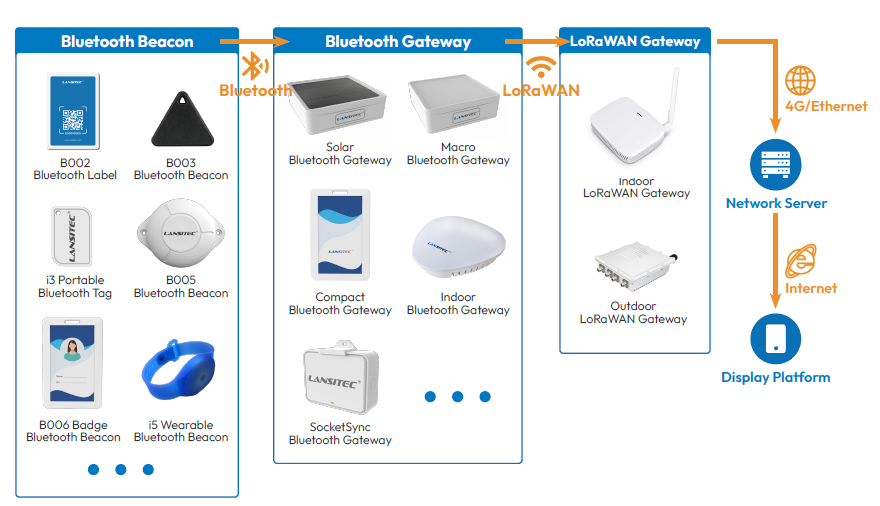
ปัจจุบัน LoRaWAN ถูกใช้ที่ไหน?
เมืองอัจฉริยะ: ไฟถนน ที่จอดรถอัจฉริยะ ถังขยะ สถานีตรวจวัดคุณภาพอากาศ
โลจิสติกส์และการติดตามทรัพย์สิน: พาเลท, คอนเทนเนอร์, ม้วนฟิล์มที่ส่งคืนได้, ปศุสัตว์
สาธารณูปโภค: มิเตอร์แก๊ส/น้ำ/ไฟฟ้า ตรวจจับการรั่วไหล ตำแหน่งวาล์ว
เกษตรกรรม: ความชื้นในดิน สถานีตรวจอากาศ การควบคุมการชลประทาน
อุตสาหกรรม/อาคาร: การตรวจสอบสภาพ HVAC การครอบครอง ความปลอดภัยของคนงานที่ทำงานคนเดียว
เหตุใด LoRaWAN จึงแตกต่าง?
- แบตเตอรี่ก่อน อุปกรณ์จะส่งข้อมูลเฉพาะเมื่อมีข้อมูลเท่านั้น โดยวิทยุจะอยู่ในโหมดสลีป >99 % ของเวลา
- มาตราส่วน. เกตเวย์เพียงตัวเดียวสามารถให้บริการอุปกรณ์ได้หลายร้อยเครื่อง โดยเกตเวย์ LoRaWAN ในร่มและกลางแจ้งของ Lansitec มีรายชื่อ "> 500 ในเกตเวย์เดียว" ทันทีที่แกะกล่อง
- ชั้นเรียนที่ยืดหยุ่น
- คลาสเอ – พลังงานต่ำสุด ช่องดาวน์ลิงก์สั้นสองช่องหลังการอัปลิงก์แต่ละครั้ง (ค่าเริ่มต้น)
- ชั้น บี – บีคอนที่กำหนดเวลาไว้จะให้หน้าต่างดาวน์ลิงก์เพิ่มเติม
- คลาส ซี – ตัวรับจะเปิดตลอดเวลา เหมาะสำหรับตัวกระตุ้นเมื่อมีไฟฟ้าเพียงพอ
- ความเป็นเจ้าของเครือข่าย สร้างเครือข่ายส่วนตัวหรือโรมมิ่งบนผู้ให้บริการ LoRaWAN สาธารณะ
LoRa เทียบกับ LoRaWAN
เปลือย โลรา มอบชั้นทางกายภาพ (เสียงแหลมแบบดิบบนอากาศ) แต่ไม่มีการระบุที่อยู่ ไม่ต้องส่งสัญญาณซ้ำ และไม่มีการเข้ารหัสใดๆ นอกเหนือจากสิ่งที่คุณเพิ่มเอง โลราวัน ห่อวิทยุนั้นไว้ใน MAC และข้อมูลจำเพาะด้านเครือข่าย: ID อุปกรณ์และแอปพลิเคชัน ความปลอดภัย AES-128 อัตราข้อมูลแบบปรับเปลี่ยนได้ การโรมมิ่ง และแม้แต่การอัปเดตเฟิร์มแวร์
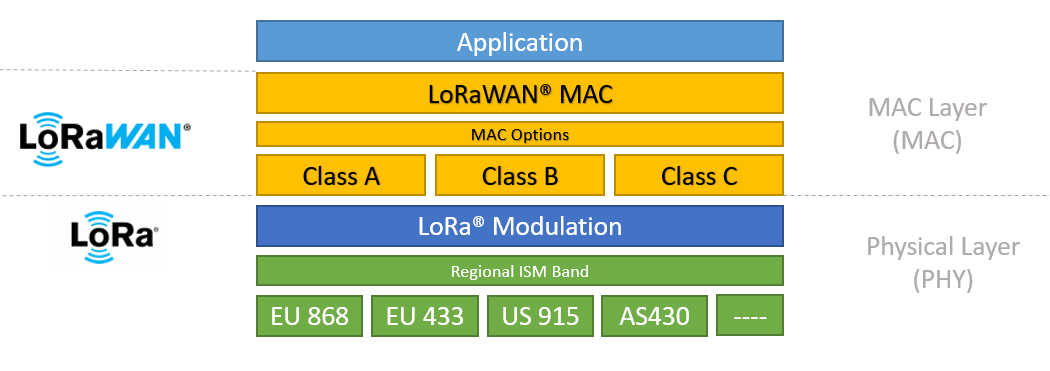
คำถามที่พบบ่อย
LoRaWAN สามารถทำงานได้ทั้งในร่มและกลางแจ้งหรือไม่?
เกตเวย์หนึ่งตัวสามารถรองรับอุปกรณ์ได้กี่เครื่อง?
LoRaWAN ใช้ความถี่อะไร?
ระยะปกติอยู่ที่เท่าไร?
มันปลอดภัยมั้ย?
แบตเตอรี่จะใช้งานได้นานแค่ไหน?
สภาพอากาศส่งผลต่อ LoRaWAN หรือไม่?
ฉันต้องมีใบอนุญาตหรือไม่?
ADR คืออะไร?
แตกต่างจาก NB-IoT หรือ LTE-Cat 1 อย่างไร?
เกตเวย์บลูทูธ LoRaWAN โดย Lansitec
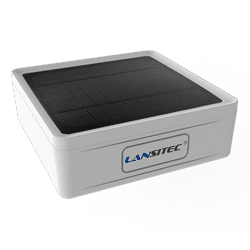
เกตเวย์บลูทูธพลังงานแสงอาทิตย์ LoRaWAN
การชาร์จแผงโซล่าเซลล์
เกตเวย์บลูทูธพลังงานแสงอาทิตย์ LoRaWAN ของ Lansitec ได้รับการออกแบบโดยอาศัยเทคโนโลยี LoRaWAN และบลูทูธ 5.0 โดยจะรับข้อความบีคอนบลูทูธที่อยู่ใกล้เคียง แล้วส่งต่อไปยังเกตเวย์ LoRaWAN ผ่าน LoRaWAN หลังจากปรับโครงสร้างข้อมูลแล้ว
ดูรายละเอียดเกตเวย์บลูทูธไมโคร LoRaWAN
เพิ่มการมองเห็นสินทรัพย์ในร่มด้วย Micro Bluetooth Gateway ของ Lansitec ซึ่งเป็นสะพาน LoRaWAN/BLE ขนาดพอดีมือที่รวบรวมข้อมูลบีคอนและเซ็นเซอร์แบบเงียบๆ และส่งต่อไปยังคลาวด์ในเวลาใกล้เคียงกับเวลาจริง
ดูรายละเอียด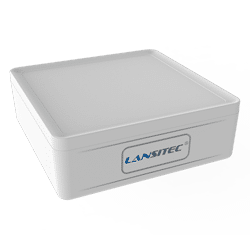
เกตเวย์บลูทูธมาโคร LoRaWAN
แบตเตอรี่ขนาดใหญ่
Lansitec LoRaWAN Macro Bluetooth Gateway ได้รับการออกแบบโดยอิงเทคโนโลยี LoRaWAN และ Bluetooth 5.0 โดยจะรับข้อมูลบีคอนใกล้เคียงและส่งต่อไปยังเกตเวย์ LoRaWAN ใช้พลังงานจากแบตเตอรี่อุตสาหกรรมขนาด 38,000mAh สแตนด์บายได้นานถึง 7 ปี
ดูรายละเอียด
เกตเวย์ความใกล้ชิดมาโคร
เซ็นเซอร์ตรวจจับระยะใกล้นี้รองรับบลูทูธ 5.0 และ LoRaWAN เมื่อบีคอนบลูทูธเข้ามาใกล้ เซ็นเซอร์จะส่งเสียงหึ่งๆ และกระพริบ จากนั้นจะส่งข้อมูล ID ของบีคอนและตัวบ่งชี้ความแรงของสัญญาณที่ได้รับ (RSSI) ไปยังเกตเวย์ LoRaWAN
ดูรายละเอียด
เกตเวย์บลูทูธภายในอาคาร
สำหรับสถานการณ์ในร่ม
เกตเวย์บลูทูธภายในอาคารของ Lansitec ใช้เทคโนโลยีบลูทูธ 5.0 และ LoRaWAN โดยจะรับข้อความบีคอนบลูทูธที่อยู่ใกล้เคียงและส่งต่อไปยังเซิร์ฟเวอร์ผ่าน LoRaWAN ด้วยเทคโนโลยี LoRaWAN จึงไม่มีค่าธรรมเนียมการใช้งานเครือข่ายสำหรับการส่งข้อมูลระยะไกล
ดูรายละเอียด
เกตเวย์บลูทูธขนาดกะทัดรัด
ขนาดเล็ก
เกตเวย์บลูทูธ Lansitec Compact ของ Lansitec ใช้เทคโนโลยี Bluetooth 5.0 และ LoRaWAN โดยจะรับข้อความบีคอนบลูทูธที่อยู่ใกล้เคียงและส่งต่อไปยังเซิร์ฟเวอร์ผ่าน LoRaWAN แบตเตอรี่แบบชาร์จไฟได้ในตัวขนาด 600mAh ใช้งานได้นานประมาณ 10 ชั่วโมงเมื่อไม่ได้ใช้งาน
ดูรายละเอียด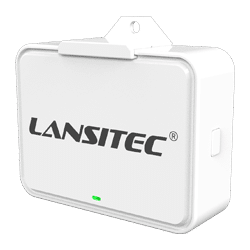
เกตเวย์บลูทูธซิงค์ซ็อกเก็ต
ติดตั้งง่ายแบบ "เสียบแล้วเล่น"
Lansitec SocketSync Bluetooth Gateway ได้รับการออกแบบโดยอิงตามเทคโนโลยี BLE และ LoRa ด้วยเทคโนโลยี LoRa ขั้นสูงและโมดูล BLE ในตัว BLE gateway จึงสามารถรับและรายงานข้อความจากอุปกรณ์ BLE ไปยังเกตเวย์ LoRaWAN
ดูรายละเอียด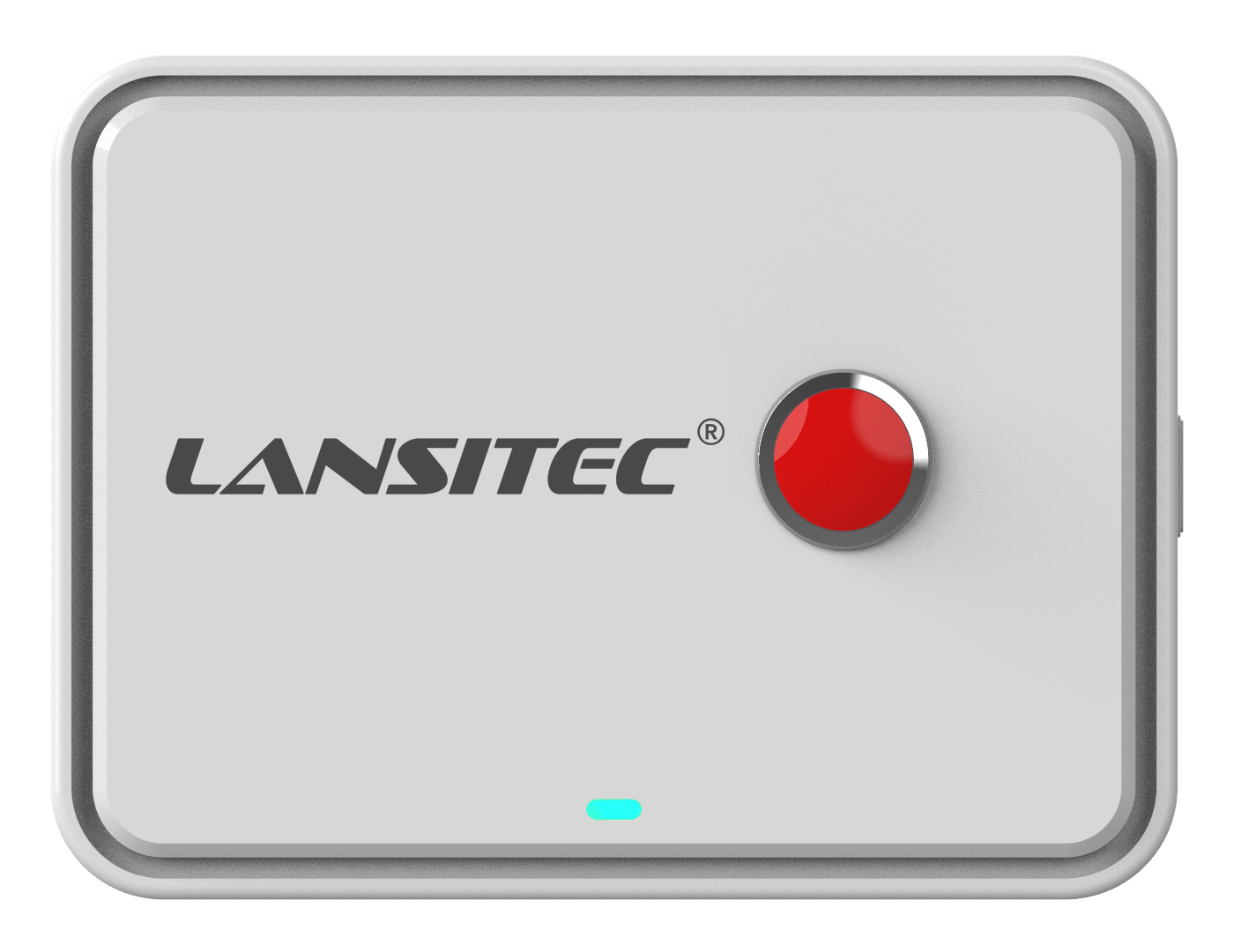
เกตเวย์ Proximity SocketSync
ยกระดับความปลอดภัยภายในอาคารและความแม่นยำในการติดตามด้วย SocketSync Proximity Gateway อุปกรณ์ขนาดกะทัดรัดนี้ผสานเทคโนโลยี Bluetooth 5.0 และ LoRaWAN เข้าด้วยกัน ไม่เพียงแต่รวบรวมและส่งต่อข้อมูลเซ็นเซอร์ BLE ไปยังเครือข่าย LoRaWAN เท่านั้น แต่ยังแจ้งเตือนคุณด้วยเสียงหึ่งๆ และไฟกระพริบเมื่อสัญญาณ Bluetooth เข้าสู่ระยะตรวจจับที่กำหนดไว้ล่วงหน้า
ดูรายละเอียดเครื่องติดตาม LoRaWAN โดย Lansitec
ตัวติดตามป้าย LoRaWAN
ส่วนใหญ่เพื่อการติดตามบุคลากร
Lansitec LoRaWAN Badge Tracker ได้รับการออกแบบโดยใช้เทคโนโลยี GNSS, Bluetooth 5.0 และ LoRaWAN รองรับการติดตามทั้งภายในและภายนอกอาคาร ป้ายนี้ส่วนใหญ่ใช้สำหรับการจัดการบุคลากรและทรัพย์สิน ตัวเร่งความเร็ว 3 แกนในตัวสามารถใช้ในการระบุสถานะการเคลื่อนที่ของเทอร์มินัลได้
ดูรายละเอียดตัวติดตามคอนเทนเนอร์ LoRaWAN
สำหรับการติดตามตู้คอนเทนเนอร์หรือทรัพย์สินอื่น ๆ
Lansitec LoRaWAN Container Tracker ได้รับการออกแบบโดยใช้เทคโนโลยี GNSS, Bluetooth และ LoRaWAN สำหรับการติดตามทั้งภายในและภายนอกอาคาร ตัวเครื่องมีระยะเวลาสแตนด์บายที่ยาวนานเป็นพิเศษและมาตรฐาน IP68 เหมาะอย่างยิ่งสำหรับการติดตามทรัพย์สิน
ดูรายละเอียด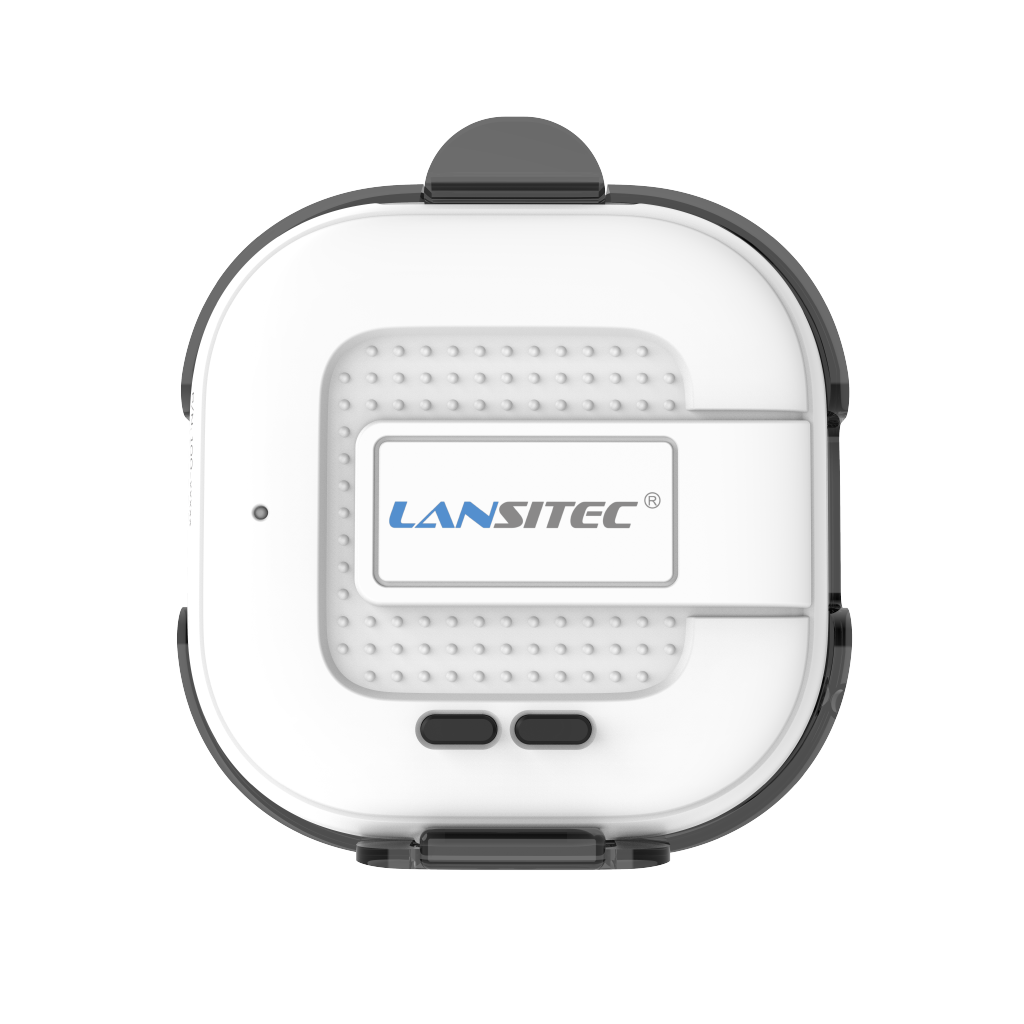
เซ็นเซอร์หมวกกันน็อค
ติดหมวกกันน็อคเพื่อความปลอดภัยของคนงาน
เซ็นเซอร์หมวกนิรภัย Lansitec ได้รับการออกแบบโดยใช้เทคโนโลยี GNSS, Bluetooth 5.0 และ LoRaWAN รองรับการติดตามทั้งภายในและภายนอกอาคาร รองรับฟีเจอร์ต่างๆ ที่ช่วยให้การจัดการในโรงงานอุตสาหกรรมเป็นเรื่องง่าย ตัวเร่งความเร็ว 3 แกนในตัวสามารถใช้ในการระบุสถานะการเคลื่อนไหวของเครื่องได้
ดูรายละเอียดป้ายติดตามผู้สัมผัส
รักษาระยะห่างที่ปลอดภัย
ป้ายติดตามการสัมผัส Lansitec ได้รับการออกแบบโดยใช้เทคโนโลยี Bluetooth 5.0 และ LoRaWAN โดยใช้ RSSI สำหรับการวัดระยะทางและการติดตามการสัมผัส ป้ายสามารถแจ้งเตือนผู้ใช้ผ่านระบบสั่นและเสียงได้แม้ไม่มีเครือข่าย LoRaWAN นอกจากนี้ยังมีฟังก์ชัน NFC ในตัวเพื่ออำนวยความสะดวกในการจัดการ
ดูรายละเอียด
ตัวติดตามแมโคร
แบตเตอรี่ขนาดใหญ่
Lansitec Macro Tracker ได้รับการออกแบบโดยใช้ GNSS, Bluetooth และ LoRaWAN สำหรับการติดตามทั้งภายในและภายนอกอาคาร ใช้พลังงานจากแบตเตอรี่อุตสาหกรรมขนาด 38,000mAh ที่มีระยะเวลาสแตนด์บายนานถึง 7 ปี
ดูรายละเอียด
เครื่องติดตามแสงอาทิตย์
การชาร์จพลังงานแสงอาทิตย์
เครื่องติดตามพลังงานแสงอาทิตย์ Lansitec ได้รับการออกแบบโดยใช้ GNSS, Bluetooth และ LoRaWAN สำหรับการติดตามทั้งภายในและภายนอกอาคาร ใช้พลังงานจากฟิล์มโซลาร์เซลล์ที่ทนทานและแบตเตอรี่แบบชาร์จไฟได้ขนาด 5300mAh
ดูรายละเอียด
ฉลากติดตาม
การออกแบบที่บางและกะทัดรัด
ฉลากติดตาม Lansitec LoRaWAN ได้รับการออกแบบโดยอิงตามเทคโนโลยี GNSS, Bluetooth 5.0 และ LoRaWAN รองรับการติดตามทั้งภายในและภายนอกอาคาร ฉลากที่บางเฉียบทำให้เป็นอุปกรณ์แบบใช้แล้วทิ้งที่สมบูรณ์แบบสำหรับการติดตามพัสดุภัณฑ์ พาเลท และตู้คอนเทนเนอร์ทุกประเภท
ดูรายละเอียดตัวติดตามการจัดการสินทรัพย์
การติดตามทรัพย์สิน
Asset Management Tracker ได้รับการออกแบบโดยใช้เทคโนโลยี GNSS, Bluetooth และ LoRaWAN สำหรับการติดตามทั้งภายในและภายนอกอาคาร ตัวเครื่องมีระยะเวลาสแตนด์บายที่ยาวนานเป็นพิเศษและมาตรฐาน IP68 เหมาะอย่างยิ่งสำหรับการติดตามทรัพย์สิน
ดูรายละเอียดเซ็นเซอร์ LoRaWAN โดย Lansitec

เซ็นเซอร์อุณหภูมิและความชื้น LoRaWAN
เซ็นเซอร์วัดอุณหภูมิและความชื้น Lansitec ได้รับการออกแบบโดยใช้การมอดูเลต LoRa ขั้นสูง และใช้แบตเตอรี่ลิเธียมที่มีอายุการใช้งาน 5 ปี เซ็นเซอร์นี้จึงเป็นอุปกรณ์ปลายทาง LoRaWAN ที่คุ้มค่าสำหรับการใช้งานที่หลากหลาย
ดูรายละเอียดเซ็นเซอร์ตำแหน่งวาล์ว
เซ็นเซอร์กำหนดตำแหน่งวาล์ว Lansitec ใช้เทคโนโลยี LoRa และเซ็นเซอร์แม่เหล็กในตัวเพื่อติดตามมุมการหมุนของวาล์วด้วยความแม่นยำ 1° อุปกรณ์ขนาดกะทัดรัดนี้วัดทั้งทิศทางและจำนวนรอบทั้งหมด พร้อมรายงานข้อมูลแบบเรียลไทม์ไปยังเกตเวย์ LoRaWAN
ดูรายละเอียดเกตเวย์ LoRaWAN โดย Lansitec
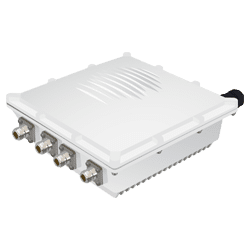
เกตเวย์ LoRaWAN กลางแจ้ง
เกตเวย์ LoRaWAN อุตสาหกรรม
Lansitec Outdoor LoRaWAN Gateway เป็นผลิตภัณฑ์ที่เหมาะสำหรับการใช้งาน IoT เชิงพาณิชย์ ด้วยคุณสมบัติแบบแยกส่วนและตัวเลือกการปรับแต่งที่หลากหลาย ช่วยให้สามารถปรับใช้โซลูชันได้อย่างยืดหยุ่น ด้วยส่วนประกอบระดับอุตสาหกรรม จึงทำให้มีมาตรฐานความน่าเชื่อถือสูง
ดูรายละเอียด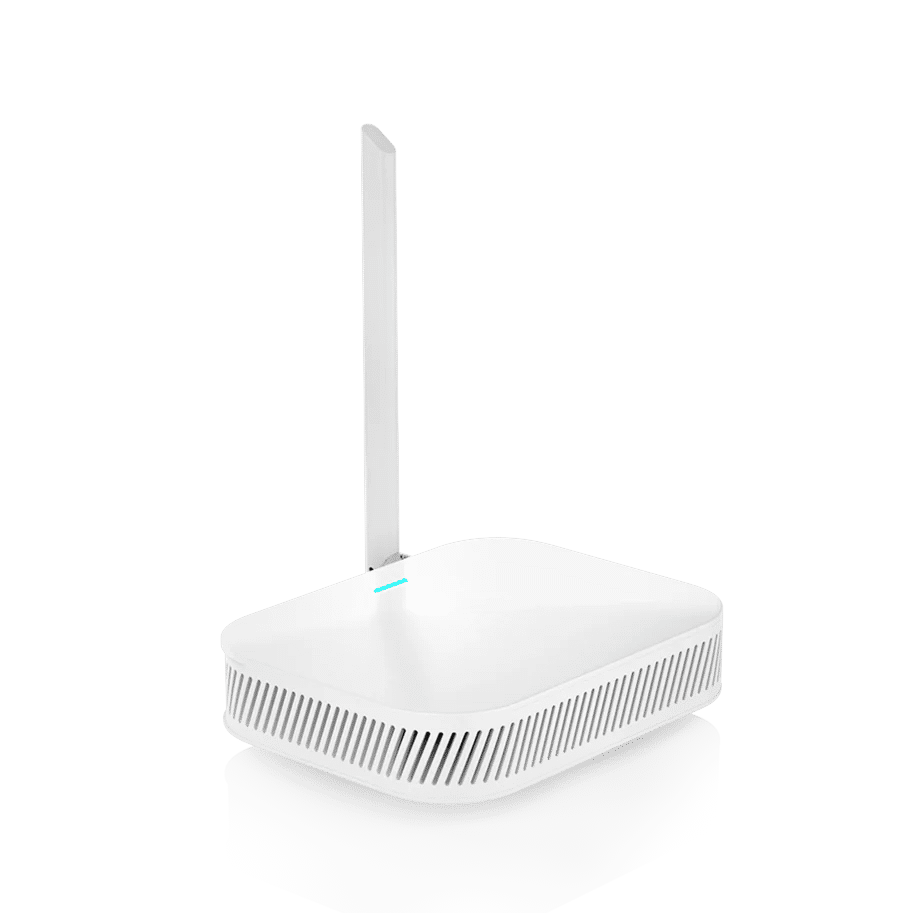
เกตเวย์ LoRaWAN ในร่ม
เกตเวย์ LoRaWAN เชิงพาณิชย์
Lansitec Indoor LoRaWAN Gateway เป็นผลิตภัณฑ์ที่เหมาะสำหรับการใช้งานภายในอาคาร ด้วยการเชื่อมต่ออีเทอร์เน็ตในตัวเพื่อการตั้งค่าที่ง่ายดาย นอกจากนี้ ยังมีการติดตั้ง Wi-Fi ในตัว (รองรับ Wi-Fi 2.4 GHz) ซึ่งช่วยให้กำหนดค่าได้อย่างง่ายดายผ่านโหมด Wi-Fi AP เริ่มต้น เกตเวย์นี้รองรับการจ่ายไฟผ่านอีเทอร์เน็ต (PoE) ในกรณีที่ติดตั้งบนผนังหรือเพดาน ซึ่งไม่สามารถติดตั้งสายไฟเพิ่มเติมได้
ดูรายละเอียด